Home / Classical Connections
Classical Connections
The location of the Gandharan region along the ancient “silk route” made it a place where cultures crossed and connected. In the sixth century BCE Gandhara was a province of King Darius I of Persia. About two hundred years later Alexander the Great conquered Gandhara. In 305 BCE the Indian Mauryan dynasty took control of the region, but fifty-five years later the Iranian horsemen of the steppes, the Parthians, were ruling there. The Indo-Greeks who occupied Gandhara around 180 BCE were responsible for the western, Hellenistic influence that is visible in many of the works on view in this exhibition. In the first century CE, Gandhara came under the rule of the Kushana, a nomadic people from the steppes of Central Asia. In addition to the Gandharan region of present-day Pakistan, the Kushan Empire included eastern Parthia in present-day Iran, the Kabul Valley, and parts of Kashmir and northern India. Buddhism and Buddhist art flourished under the Kushana’s most important ruler, Kanishka I (ca. 127–150), although the cosmopolitan Kushana also supported other religions.
In this section of the exhibition, Gandharan art is exhibited alongside select works from India and the Roman world to highlight the stylistic and iconographic links and distinctions between these cultures. Although Buddhist imagery dominates the art of Gandhara, some Hindu deities such as Skanda, the god of war, were also common. Early art from Gandhara often features motifs from Greco-Roman mythology and imperial representations, as well as western architectural elements such as Corinthian capitals and friezes of garland-bearing, cupid-like erotes. These characteristics make Gandharan works truly distinctive in the history of art.
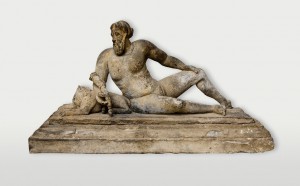
River god 1st–2nd century CE Stone H. 7 3/4 x W. 14 in. (19.7 x 35.5 cm) National Museum of Pakistan, Karachi, 42
This river god is inspired by Roman prototypes, both in the rendering of the figure and in its depiction as a male. Personifications of rivers in Indian culture are always female.
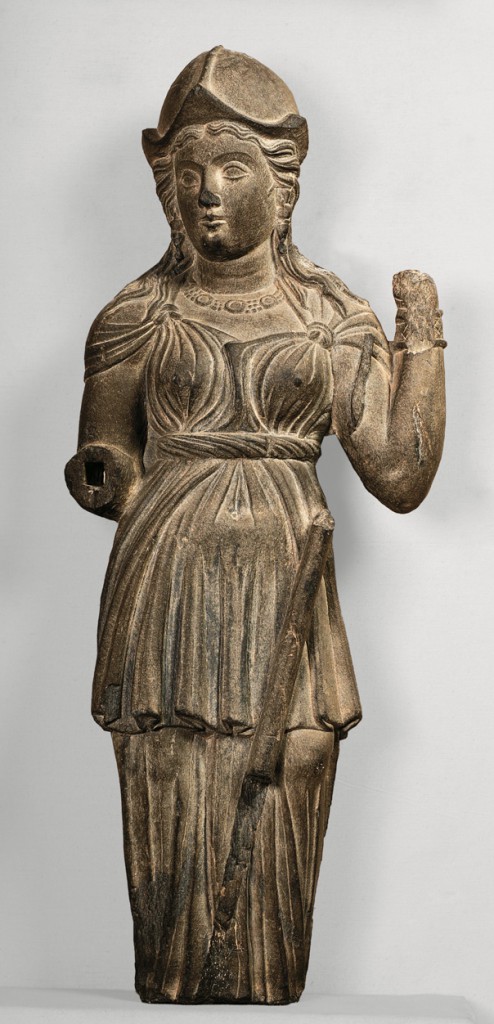
So-called Athena 2nd century CE Schist H. 32 1/2 x W. 13 x 5 1/8 in. (82.5 x 33 x 13 cm) Lahore Museum, G-162
This female figure strongly resembles the Greek goddess Athena. She may be the goddess herself, or simply a patron goddess of a Gandharan city whose image is inspired by Athena.

Figure capital with seated Buddha 2nd–3rd century CE Schist H. 4 5/16 x W. 24 7/16 x D. 8 1/4 in. (11 x 62 x 21 cm) Lahore Museum, G-216
Like many Roman Corinthian capitals, this capital features leaves that curl upwards from the base. Some Roman Corinthian capitals include a single flower centered at the very top. In the capitals from Gandhara on view, a buddha graces this position. Here, his right hand is raised in the gesture of fearlessness (abhayamudra) and his left rests in his lap and holds a begging bowl (patra).
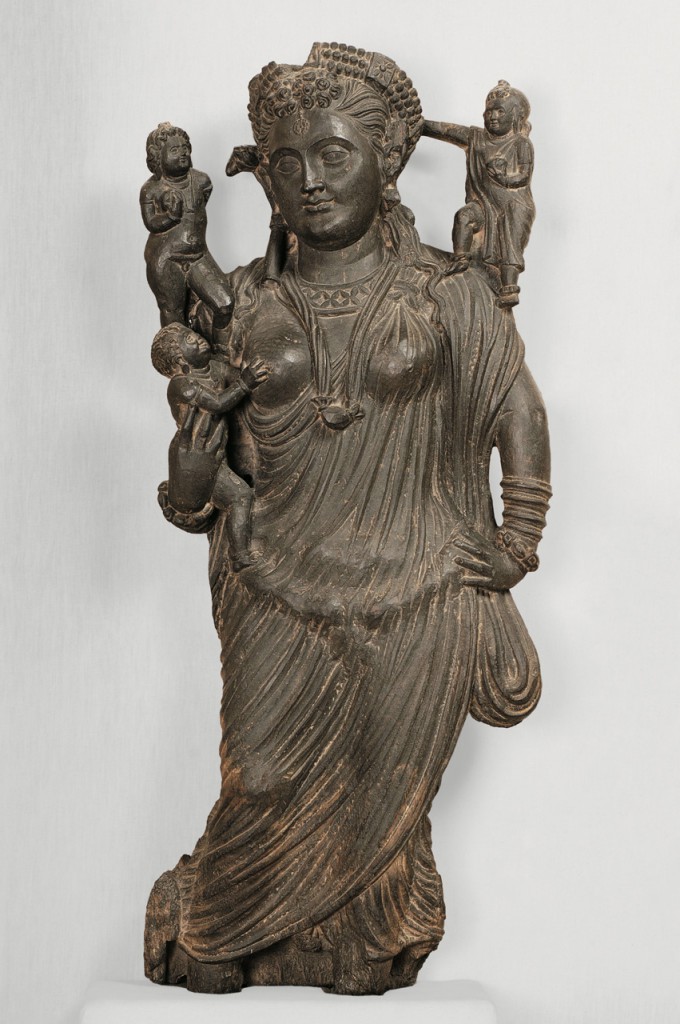
The goddess Hariti with three children Sikri, Khyber Pakhtunkhwa province 2nd–3rd century CE Schist H. 36 1/4 x W. 14 3/16 x D. 5 1/8 in. (92 x 36 x 13 cm) Lahore Museum, G-102
According to legend, the child-eating demon Hariti converted to Buddhism. Her cult enjoyed great popularity in Gandhara, and she appears to have been associated with the Greek and Roman personifications of abundance and good fortune, Abundantia and Fortuna/Tyche. Images of these divinities were probably introduced to the Gandharan region in the form of portable bronze or clay statuettes, coins, and cameos.
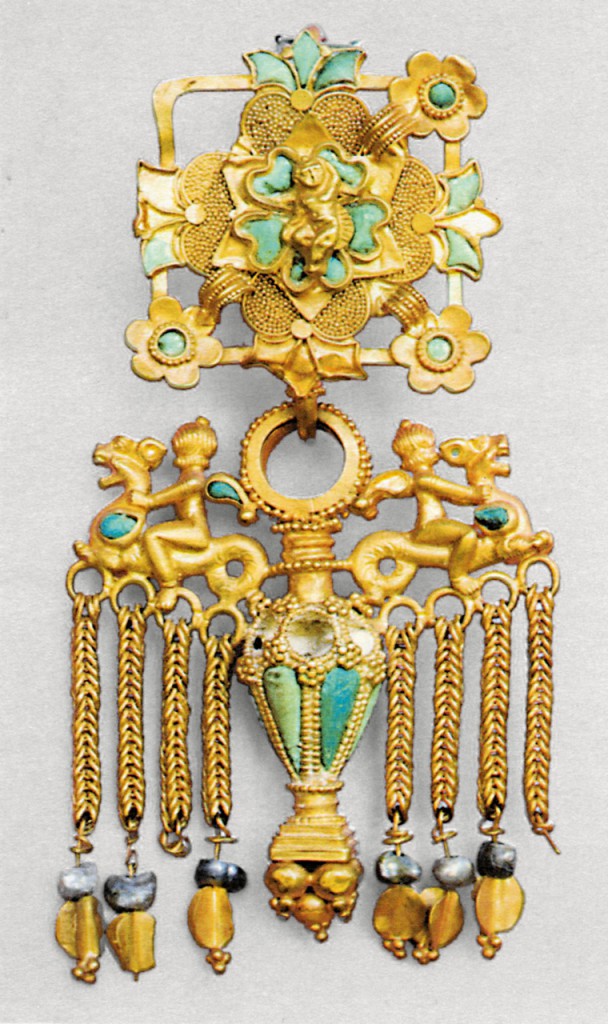
Ear pendant with riders. Sirkap, Taxila, Khyber Pakhtunkhwa province 1st century CE. Gold and turquoise. H. 4 5/16 in. (10.9 cm). National Museum of Pakistan, Karachi, 50.81
A craftsman used fine granulation, gold filigree, and inlaid turquoise to fashion this pendant, which was most likely an earring originally. A pair of erotes mounted on ketoi (sea monsters) are separated by a central amphora-shaped element. An Eros (Cupid) rests on the center of the large open blossom above.
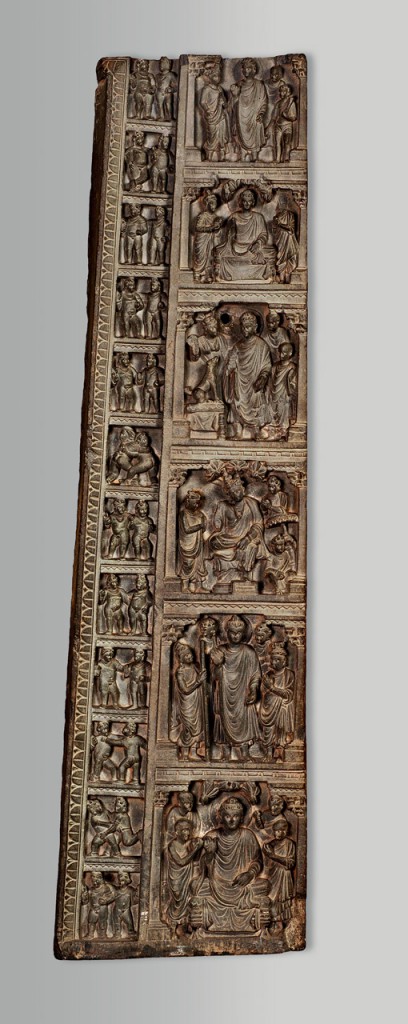
Stele with scenes from the life of the Buddha and erotes Mohammed Nari, Khyber. Pakhtunkhwa province 3rd century CE. Schist H. 46 7/16 x W. 13 x D. 3 3/8 in. (118 x 33 x 8.5 cm) Lahore Museum, G-109
Alternating panels showing the Buddha and pensive bodhisattvas are carved into this stele. One scene shows a dog barking at the Buddha, reminding him of his past incarnation. In another scene a young Brahman attempts to measure the Buddha and fails. Cupid-like erotes appear on the left.


 Share
Share